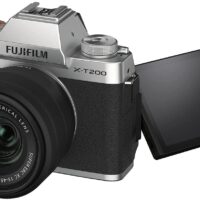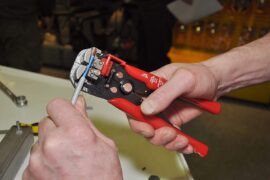It has always been said that for videos, mirrorless cameras are the best. That is generally true, but there are specific DSLR models that can challenge that notion.
Nowadays, there are lots of DSLR models built not just to excel in stills but to shoot excellent videos, as well. This includes the Canon EOS-1D X Mark III, Nikon D850, Nikon D780, and more. But what makes them excellent for video projects?
Besides the great battery life and a vast selection of lenses, camera brands nowadays are tailoring their DSLR units with adequate numbers of video features. For instance, while it seems typical to have a fully articulating touchscreen LCD these days, having one when shooting videos at awkward angles can be very helpful.
The resolution and frame rate also matter. Ideally, getting 4K is very typical now in DSLR models but keep in mind that not all of them would offer you uncropped videos. If you want to get the best out of your lens and footage, the removal of crop factors can be a huge deal. On the other hand, getting all the access to different frame rates will also benefit you; and the higher the frames rates, the better. Not only would it make the actions of the subjects look smoother, but it will allow you to create efficient slow-mo effects in your videos.
The availability of reliable autofocus for videos can also be helpful. Though videographers often fancy doing the focus manually, more modern users (especially beginners) would find using AF more preferable. If you are included in the latter type, the Canon EOS-1D X Mark III is your best choice. It uses the new EOS iTR AFX or Deep Learning AF which employs an advanced algorithm that allows it to aggressively prioritize the human head. Most of all, regardless of speed and things blocking the head, it can still recognize it.
To give you more insights about the important aspects we discussed above, we picked the best DSLR for videos that offer them. With the help of SolidSmack Photography Editor, Evangeline Summers, we tested and compared each of them in order to highlight their best strengths and weaknesses. Let’s have a look:
Best DSLR for Video Comparison & Rating
DSLR for Video | Features |
2. Nikon D850 | |
3. Nikon D780 | |
1. Canon EOS-1D X Mark III





EOS-1D X Mark III is probably the ultimate DSLR you can have from Canon and the best of the best in terms of DSLR video. It offers all the things you need for videography: 4K RAW, 4K DCI, 4K UHD, 4K DCI Cropped, and Full HD. Even for the frame rates, it impresses. It offers 60fps to most of the video modes and up to 120fps for Full HD. This is a relief for videographers who have always been looking for a powerful DSLR without the irritating crop factors. Even better, the videos come crisp and vivid.
The resolution, nonetheless, isn’t the only thing EOS-1D X Mark III can brag about. It offers serious professional video shooting capabilities. This includes the fact that it can record MP4 and RAW at the same time since the model now caters to CFexpress cards!
On the other hand, it is undeniable that its size is no joke. It is not of those DSLR units suggested for handheld use for an extended period of time.
“This perhaps explains the absence of a fully articulating screen. If you are one of those users who often rely on tripods, the said things won’t be of any issue. However, for individuals who would like to shoot at high- and low-angled positions, it could be a problem,” Summers said.
Further, while the EOS-1D X Mark III lacks image stabilization (though there’s electronic stabilization), you get a bombastic AF system from Canon. And when we say bombastic, it really is bombastic. Compared to other models produced by the brand using the typical algorithm of Dual Pixel CMOS AF, the EOS-1D X Mark III presents a new AF method in the form of EOS iTR AFX. Also called the Deep Learning AF, it maximizes the power of the cam’s Digic X processor to track subjects at breakneck speed.
“To give a better view of this system, imagine a subject riding a motorcycle at full speed. The brilliant thing about the iTR AFX is that its algorithm is set to focus on the head of the subjects whether they are wearing helmets or not. This predicts the action of the subject which makes it possible for the AF system to follow the subject regardless of speed. You will enjoy its full benefits through the Live View option where the Digic X processor works its magic using the 3,869 Dual Pixel CMOS AF points and eye detect AF,” said Summers.
2. Nikon D850




Nikon D850 doesn’t have the competitive AF system of Canon. It employs contrast-based autofocus (though it seems way faster than what other Nikon cameras have) in Live View which can be unattractive but it compensates greatly on other sections: it has a full-frame sensor… with a 45.7 MP resolution!
“In terms of resolution, the Nikon D850 is certainly unbeatable. With the full-frame sensor it is using, this results in extremely high-resolution videos which can be tough to beat. Detail by detail, you get the finest information you need,” said Summers.
Moreover, the video comes in 4K. The good news? No crop factor. With this, you’ll be able to enjoy the full scene of your footage and the focal lengths of the lens.
“The frame rate is available in 24, 25, and 30fps; nonetheless, if you want smoother actions and the best slow-mo effects, it can offer an astounding frame rate of up to 120 frames per minute at 1080p. Under this resolution, you also have the advantage of D850’s digital stabilization and focus peaking,” Summers added.
Further, you can push even further to take advantage of its high-resolution sensor using the 4K time-lapse movies which can be processed by the camera itself. If you have external software and go beyond 4K, it has an 8K time-lapse movie function.
Another big thing about D850 is that its LCD tilts. This gives it an extra edge compared to its rivals that limit your angles due to fixed LCD monitors. You can also use its touch-sensitive capability to set your focus (though, then again, it uses contrast-detect AF). However, keep in mind that it is still not the best run-and-gun equipment due to its size.
3. Nikon D780





The D780 isn’t as powerful as the D850 in terms of resolution; nonetheless, it still retains the full-frame sensor which gives you sufficient edge in your video projects. Thankfully, you also get uncropped 4K footage that is up to 30fps. You also have the choice of 50fps or 60fps under the DX mode and an astounding 120fps under full HD.
On the other hand, compared to the plain contrast-detect AF system of the Nikon D850, the D780 has changed track by acquiring 273 hybrid phase-detect points for its Live View shooting. It also has 51 phase-detect points for the viewfinder, making its autofocus more efficient than D850.
“The on-sensor phase-detect AF is very responsive during video mode, especially in detecting and following faces. There is almost no difference in the AF’s activity whether you are shooting stills or videos. It also responds quite impressively with just a tap on the screen for fast focusing,” said Summers.
Most of the video capabilities and other features of the D780 are borrowed from the well-known Nikon Z6. It includes the focus peaking, wind noise filter, zebra warnings, and more. It also doesn’t lack other features you need to aid you with your video projects. This includes the headphone and external mic sockets. Using an external recorder, the camera can also produce 10-bit Log outputs. And though it won’t give you the in-body stabilization, you still have an electronic stabilization that works decently during handheld shooting (and if you don’t mind the 1.1x crop).
4. Canon EOS 90D





Canon has proved its dominance with the release of the Canon EOS 90D DSLR. It is packed with very irresistible features that are unique in this model. It isn’t one of those powerful full-frame video DSLRs out there but for an APS-C DSLR unit, it can be considered the best. Moreover, Canon did a great job at putting in a lot of features that will help you enjoy its video capabilities even better. Besides the traditional chunky body giving you a solid grip while filming(and sufficient space for buttons!), it goes beyond the limits of DSLR units in the past: the Live View video with an effective AF, thanks to Canon’s Dual Pixel CMOS AF technology. This somehow makes it an amalgamation of a mirrorless and DSLR unit.
“This is one of the notably bold moves by Canon which used to be a unique attribute in mirrorless units. Now, EOS 90D blurs the line as it can be as effective as mirrorless models in the video category. This is very true, especially now that you can get uncropped 4K videos with EOS 90D which used to be an issue with most old DSLR models out there. Plus, it now offers headphones and a mic socket. This is a bit interesting as you rarely see a DSLR that invests a lot of features for the videography section,” said Summers.
According to Summers, EOS 90D is filled with more than 5,000 manually selectable AF points. Further, the AF area coverage of EOS 90D is also quite vast with its vertical length fully covered and the horizontal length at 88%. With this, getting the focus on the subject is much easier. All in all, the efficiency of the AF doesn’t just stop with the stills of EOS 90D. Even in video mode, the AF with the eye-detect function can keep up with the movements of the subject.
5. Canon Rebel EOS SL3





Besides being good in videos, Canon Rebel EOS SL3 (EOS 250D in other places) can also be a beginner-friendly unit for individuals who are about to have their first DSLR cameras.
“Besides giving the market a smaller size of DSLR,” Summers said, “you’ll also get other helpful functions that improve user experience. For instance, it introduces a Guided UI, a viewfinder with distinctive autofocus points, and a Creative Assist mode. All of them are targeting novice users.”
It is also one of those reasonably priced DSLRs from Canon; nonetheless, it comes with various essential functions and appealing performance, making it a wise investment for beginners and pros who are still economically conscious about their purchases.
The EOS SL3 can shoot 4K videos up to 60fps. The thing about it is that its 4K comes cropped and doesn’t use the Dual Pixel technology when using the Live View. There are of course other DSLR models that offer better video specs, but it is one of the first ones that offer 4K at this price point.
Best DSLR for Videos - Buyer's Guide
The resolution of the video is very important. While the 1080p would make the cut to give you decent-looking footage, having 4K is better as it reflects today’s video standards. And by that, we mean uncropped 4K resolution. Also, check for the available frame rates of the DSLR. It is better to have one that offers higher frame rates such as 60fps or 120fps. This can be handy in creating slow-mo effects in your footage.
The megapixels aren’t the only basis for a quality video. The size of the sensor can affect the pixels, overall detail, low-light performance, dynamic range, and noise level. Hence, the larger the sensor, the better.
Before deciding on what DSLR to have, make sure that it is designed with a considerable number of video-friendly features. Besides the tilting (but preferably fully articulating type) to allow you to get awkward shots with ease, also check for the availability of headphone and mic sockets and more.
Expect that the higher the specifications of the camera, the higher the price. Yet, do you really need a high-end DSLR? Well, it depends on your needs. Again, the 1080p resolution should be enough for anyone but if you are a professional who relies on your camera to earn, getting a quality model is a must.
Best DSLR for Videos - FAQs
It depends on your needs. The 1080p resolution should be enough for most needs, especially if you are just a beginner or enthusiast. However, to catch up with the current standard, it is best to have the 4K.
The red circle on the lens mount means the camera compliments EF lenses. If there is a red circle and a white square, it means the camera can also use EF-S lenses. Lastly, the white circle means the camera is for EF-M lenses only.
Mirrorless and DSLR cameras have their own strengths and weaknesses. While mirrorless units have more compact bodies and are relatively lighter, DSLR can offer you better battery performance and a wider selection of lenses. It is first important to determine your needs for the cameras before deciding which type to get.
Full frame sensors are much better compared to APS-C sensors for low-light photography. Since the pixels on full-frame sensors are bigger, they generate intricate details and have a better image quality than an APS-C sensor.





![Canon DSLR Camera [EOS 90D] with Built-in Wi-Fi, Bluetooth, DIGIC 8 Image Processor, 4K Video, Dual Pixel CMOS AF, and 3.0 Inch Vari-Angle Touch LCD Screen, [Body Only], Black Canon DSLR Camera [EOS 90D] with Built-in Wi-Fi, Bluetooth, DIGIC 8 Image Processor, 4K Video, Dual Pixel CMOS AF, and 3.0 Inch Vari-Angle Touch LCD Screen, [Body Only], Black](https://m.media-amazon.com/images/I/41LPfS9ugNL._SL500_.jpg)





